ECS LIVA Z3 Plus Review: Compact Comet Lake NUC Clone Cuts Corners
by Ganesh T S on December 22, 2020 8:00 AM ESTMiscellaneous Performance Metrics
This section looks at some of the other commonly used benchmarks representative of the performance of specific real-world applications.
3D Rendering - CINEBENCH
We use CINEBENCH R15, R20, and R23 for 3D rendering evaluation. R15 provides three benchmark modes - OpenGL, single threaded and multi-threaded, while R20 and R23 provide only single and multi-threaded modes. Evaluation of different PC configurations in all supported modes provided us the following results.
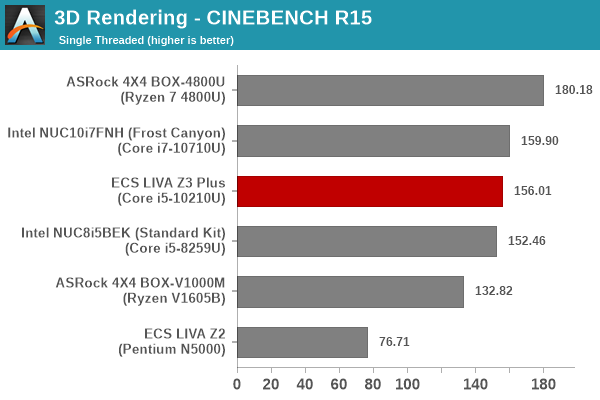
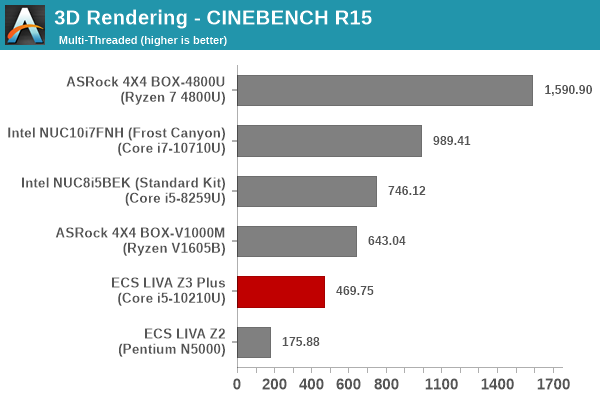

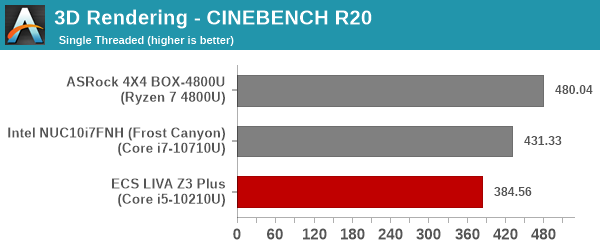
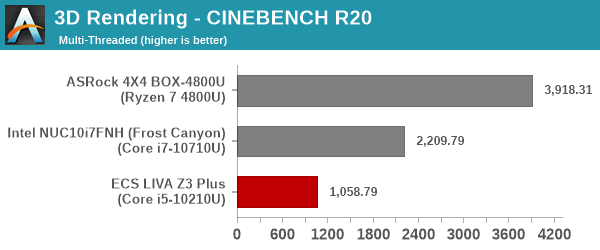
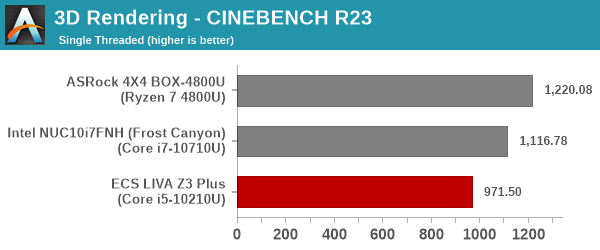
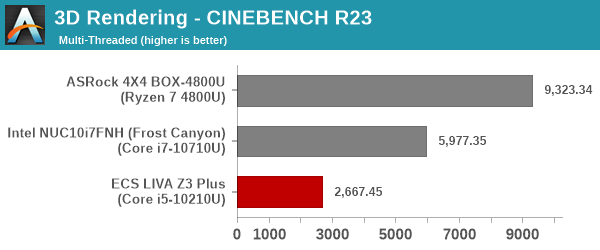
Multi-threaded and GPU performance suffers when compared against the AMD offerings with better multi-core performance and a more capable GPU. The relative ordering across all CINEBENCH releases remains the same. Clock speeds and core counts essentially dictate the ordering seen above.
x265 Benchmark
Next up, we have some video encoding benchmarks using x265 v2.8. The appropriate encoder executable is chosen based on the supported CPU features. In the first case, we encode 600 1080p YUV 4:2:0 frames into a 1080p30 HEVC Main-profile compatible video stream at 1 Mbps and record the average number of frames encoded per second.
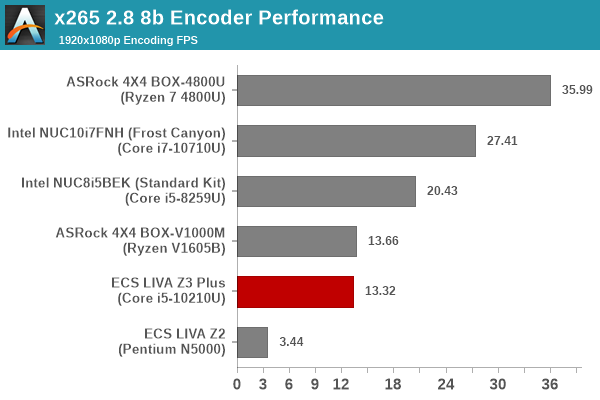
Our second test case is 1200 4K YUV 4:2:0 frames getting encoded into a 4Kp60 HEVC Main10-profile video stream at 35 Mbps. The encoding FPS is recorded.
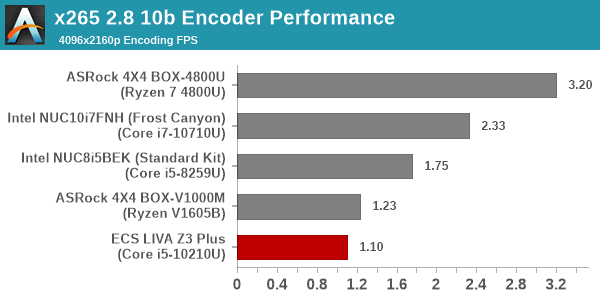
The encoder is heavily multi-threaded and the effects are clearly visible in the numbers above.
7-Zip
7-Zip is a very effective and efficient compression program, often beating out OpenCL accelerated commercial programs in benchmarks even while using just the CPU power. 7-Zip has a benchmarking program that provides tons of details regarding the underlying CPU's efficiency. In this subsection, we are interested in the compression and decompression rates when utilizing all the available threads for the LZMA algorithm.
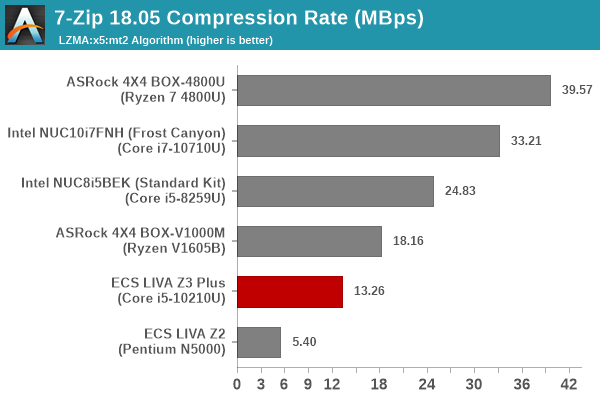
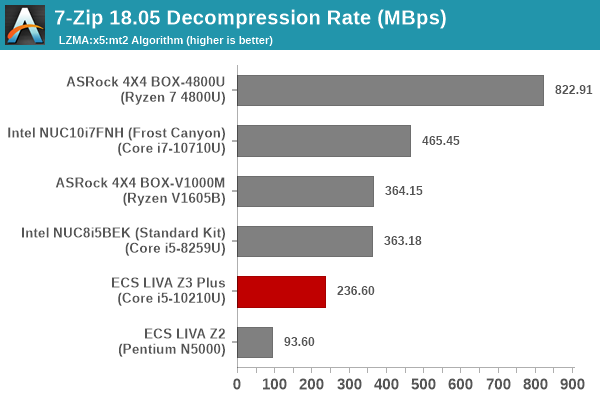
The relative ordering follows the core counts in different systems.
Cryptography Benchmarks
Cryptography has become an indispensable part of our interaction with computing systems. Almost all modern systems have some sort of hardware-acceleration for making cryptographic operations faster and more power efficient. In this sub-section, we look at two different real-world applications that may make use of this acceleration.
BitLocker is a Windows features that encrypts entire disk volumes. While drives that offer encryption capabilities are dealt with using that feature, most legacy systems and external drives have to use the host system implementation. Windows has no direct benchmark for BitLocker. However, we cooked up a BitLocker operation sequence to determine the adeptness of the system at handling BitLocker operations. We start off with a 2.5GB RAM drive in which a 2GB VHD (virtual hard disk) is created. This VHD is then mounted, and BitLocker is enabled on the volume. Once the BitLocker encryption process gets done, BitLocker is disabled. This triggers a decryption process. The times taken to complete the encryption and decryption are recorded. This process is repeated 25 times, and the average of the last 20 iterations is graphed below.
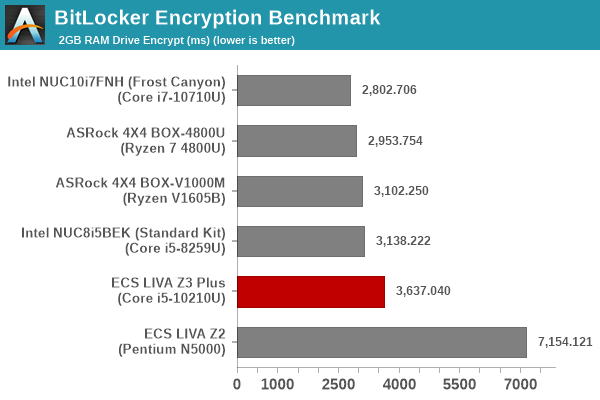
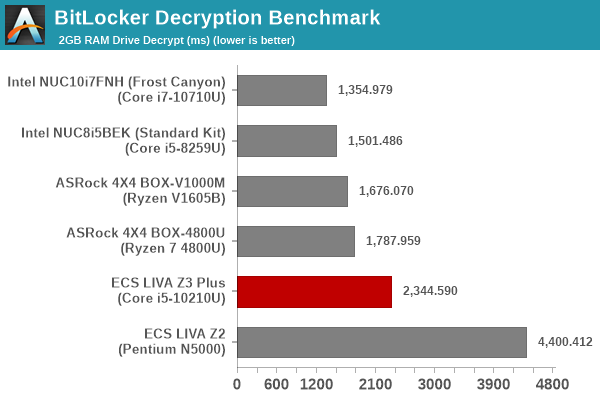
In addition to AES-NI performance dictated by core counts and clock speed, DRAM bandwidth also plays a role, and this handicap is possibly the main reason why the LIVA Z3 Plus comes in the lower half of the above graphs.
Creation of secure archives is best done through the use of AES-256 as the encryption method while password protecting ZIP files. We re-use the benchmark mode of 7-Zip to determine the AES256-CBC encryption and decryption rates using pure software as well as AES-NI. Note that the 7-Zip benchmark uses a 48KB buffer for this purpose.
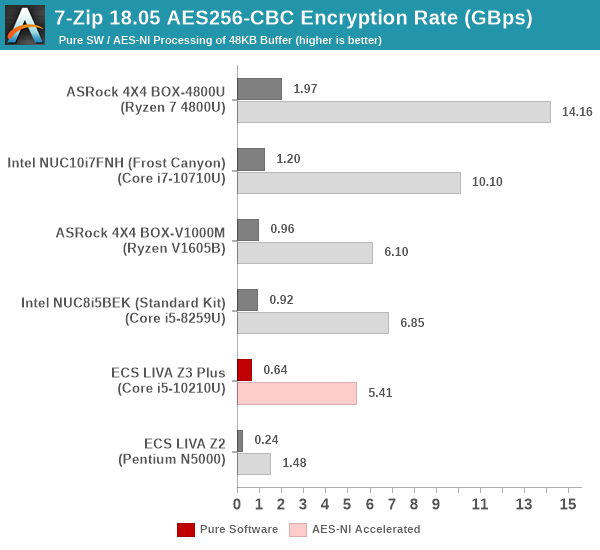

The ordering seen here is the same as what was obtained for BitLocker, though the gulf is not as wide (DRAM bandwidth probably has little to contribute here since the buffer size is small enough to fit in the cache of most processors).
Yet another cryptography application is secure network communication. OpenSSL can take advantage of the acceleration provided by the host system to make operations faster. It also has a benchmark mode that can use varying buffer sizes. We recorded the processing rate for a 8KB buffer using the hardware-accelerated AES256-CBC-HAC-SHA1 feature.
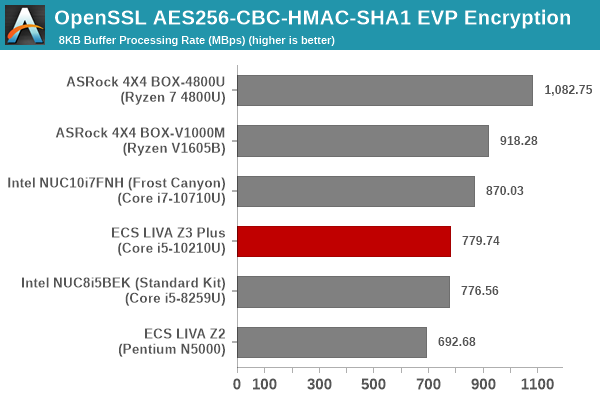
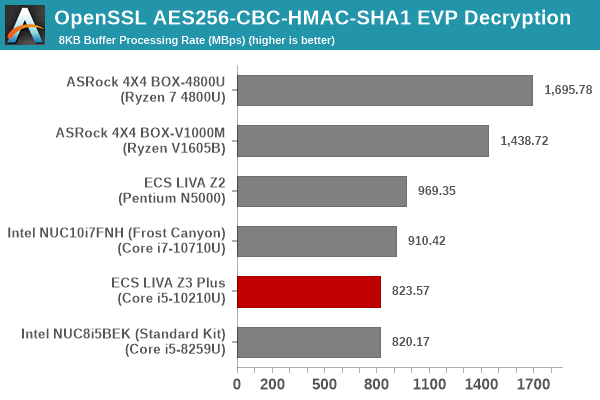
We have noted in earlier reviews that AMD's acceleration for OpenSSL ciphers delivers better results than Intel's as seen in the above graphs. The Intel systems are all around the same ballpark, with minor differences accounted for by clock speeds.
Agisoft Photoscan
Agisoft PhotoScan is a commercial program that converts 2D images into 3D point maps, meshes and textures. The program designers sent us a command line version in order to evaluate the efficiency of various systems that go under our review scanner. The command line version has two benchmark modes, one using the CPU and the other using both the CPU and GPU (via OpenCL). We present the results from our evaluation using the CPU mode only. The benchmark (v1.3) takes 84 photographs and does four stages of computation:
- Stage 1: Align Photographs (capable of OpenCL acceleration)
- Stage 2: Build Point Cloud (capable of OpenCL acceleration)
- Stage 3: Build Mesh
- Stage 4: Build Textures
We record the time taken for each stage. Since various elements of the software are single threaded, and others multithreaded, it is interesting to record the effects of CPU generations, speeds, number of cores, and DRAM parameters using this software.
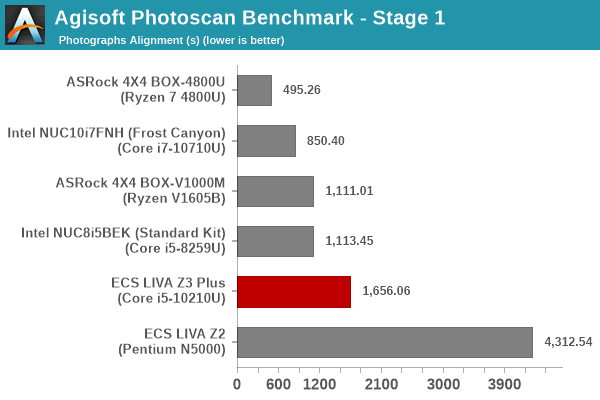
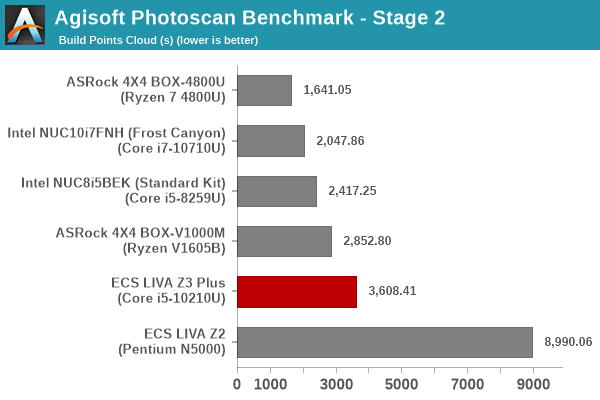

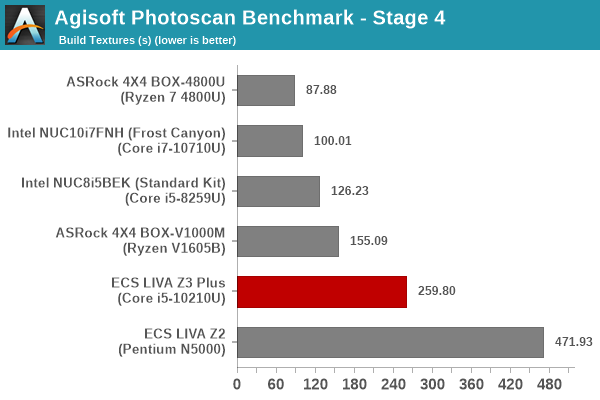
The lack of DRAM bandwidth due to single-channel operation pretty much condemns the LIVA Z3 Plus to the bottom half of the graphs despite a capable processor in the Core i5-10210U.
Dolphin Emulator
Wrapping up our application benchmark numbers is the new Dolphin Emulator (v5) benchmark mode results.

This is again a test of the CPU capabilities, and thankfully the DRAM bandwidth limitations don't have too much of a detrimental effect. Despite being in the lower half of the graph, the numbers are closer to the systems on top than the bottom.










15 Comments
View All Comments
JfromImaginstuff - Tuesday, December 22, 2020 - link
Waiting for the guy who says,"where's the and variant" or something along those linesedzieba - Tuesday, December 22, 2020 - link
And the inevitable "AMD exists so nobody is allowed to review Intel products!!1!" brigade.nandnandnand - Tuesday, December 22, 2020 - link
No AMD, no buy.stephenbrooks - Tuesday, December 22, 2020 - link
The ASRock 4X4 is in the comparison table, so your AMD SFFPC is there.Hul8 - Wednesday, December 23, 2020 - link
Also, I think as long as AMD keeps bringing new architectures to mobile/APUs late, and Intel keeps leading their new tech with mobile chips, most manufacturers will prioritize Intel for these systems. Doesn't hurt that they can get sweet bundle deals for WiFi 6 and Ethernet, too.chrnochime - Thursday, December 24, 2020 - link
Well it'd be AMD and not "and" for starters LOLShowtime - Tuesday, December 22, 2020 - link
This looks better than the Nuc to me, but all 4 USB ports on the front, make a no go. There's always 2-3 things plugged in, and I prefer those things in the back of the case. It being a bad value proposition is unfortunate. This is like many tech items, that could have been great, but will end up on sale for 50% off next year. Will cite this article when that happens.Impetuous - Tuesday, December 22, 2020 - link
Agree with you on the ports. I have the original LIVA Z for TV / media use and would much prefer to route external HDDs and Skype cameras from the back to keep cords away from grasping toddlers. Only thing I want up front is the wireless keyboard USB. All ports on the back is more of a deal breaker than the price for me...Impetuous - Tuesday, December 22, 2020 - link
Sorry, all ports on front*The_Assimilator - Tuesday, December 22, 2020 - link
Allow me to introduce you to a simple and inexpensive device called a "USB hub".